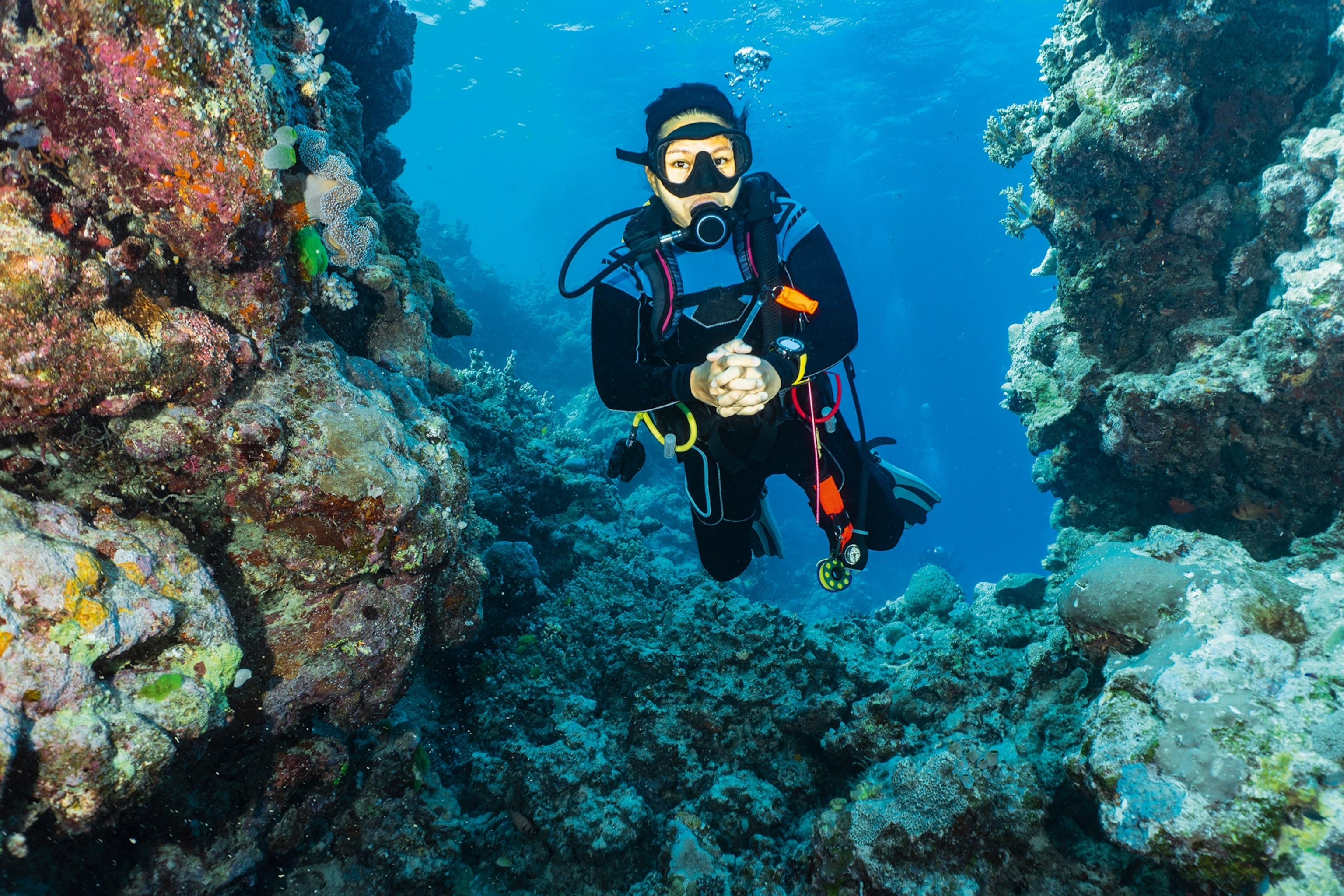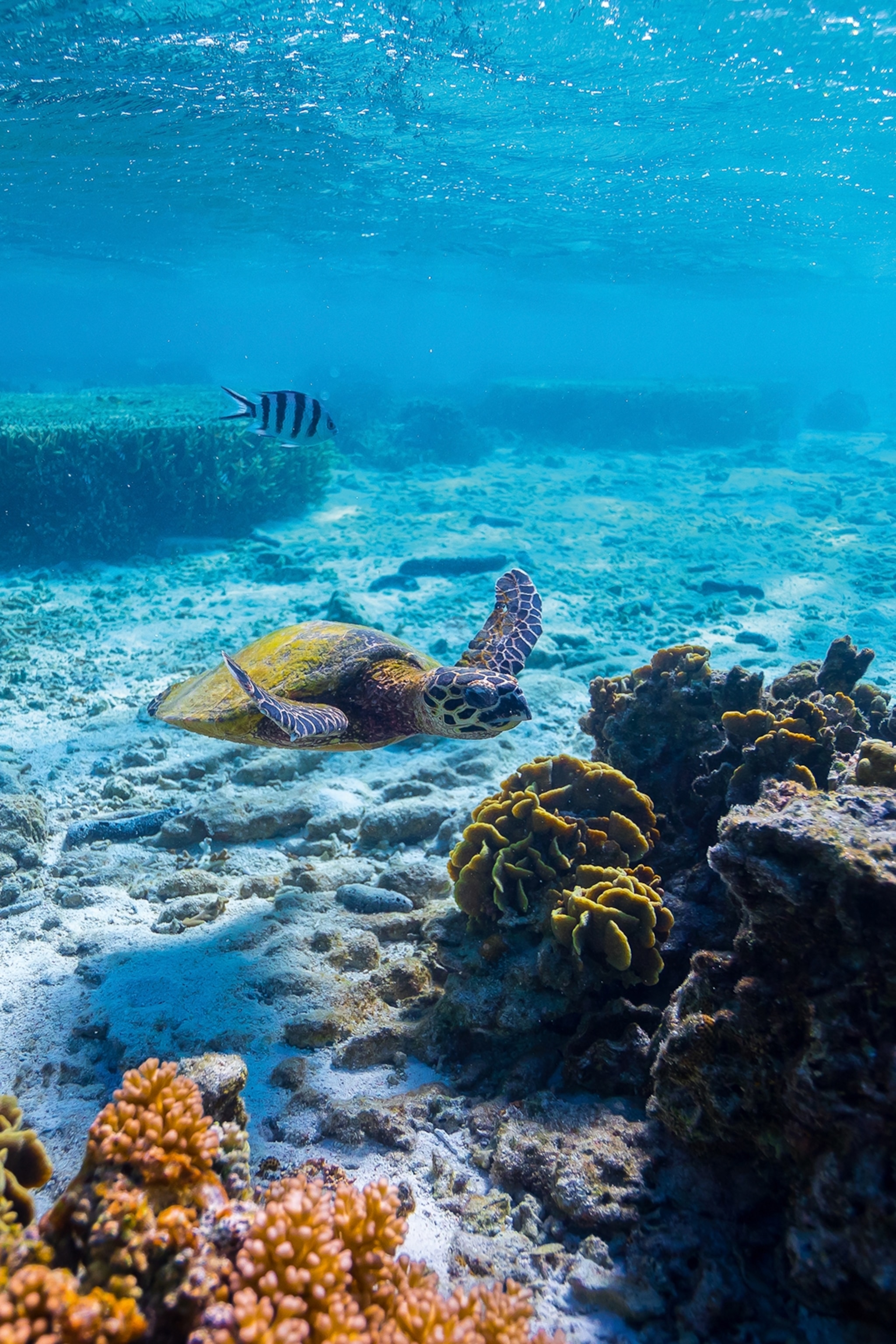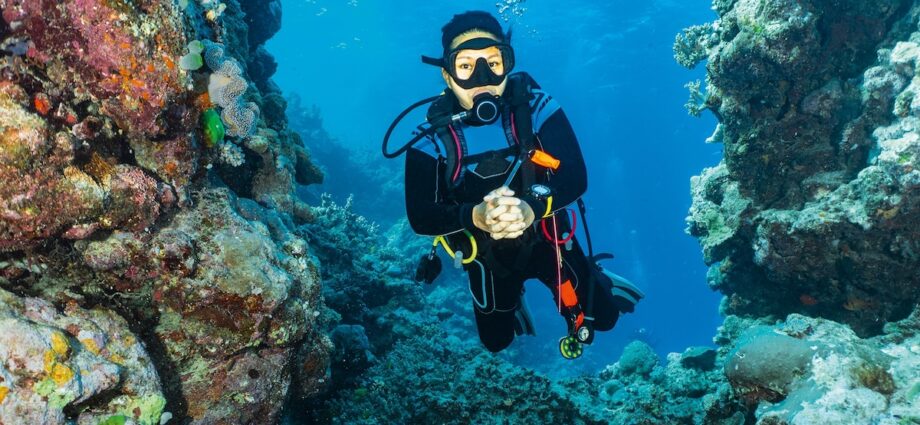This article was produced by National Geographic Traveller (UK).
The first time a giant trevally fish hits me on the forehead, I freeze. We’re 39ft below the surface of the ocean at dusk, the inky black water lit only by our torches. Thick with plankton, the beams cut through the white-speckled dark like headlights in a snowstorm. Enormous fish in their hundreds — silver, coral pink and coal black — all dart past my face, close enough to feel the chill of their scales on my skin.
I swing my torch into the abyss. Red, white and amber eyes blink back. Whitetip reef sharks — some the length of my arm, others larger than me — patrol the 98ft coral wall, their bellies swollen from a fresh kill. Moray eels crane their heads from deep cracks in brain and staghorn coral, teeth glinting in the light like knife blades. The only sounds are my short breaths and pounding heart as I kick my way through the feeding frenzy, praying my bubbles are enough to keep larger predators away.
It’s 7pm and I’m night diving off the coast of Queensland, miles from the mainland. We’ve been sailing for two days on Spirit of Freedom, a liveaboard boat bound for the white sands of Lizard Island at the far northern tip of the Great Barrier Reef, home to a world-renowned coral reef research station and a luxurious resort.
I’ve wanted to see the Great Barrier Reef since I was a child, largely thanks to the 2003 film Finding Nemo. But when I finally got the chance to visit earlier this year, I wasn’t sure what to expect. Wasn’t the reef dying? Would there be anything left to see? More importantly, would our presence here only add to the pressure on an already fragile ecosystem? I joined a three-night expedition to find out.
The morning after our night dive, we’re travelling deeper into the remote Ribbon Reefs — a chain of 10 coral formations stretching along the outer edge of the Great Barrier Reef, far beyond the reach of day boats from Cairns or Port Douglas. “The Ribbon Reefs have cooler currents and more resistant coral species,” says Mel Alps, the PADI master instructor leading our dives and one of four Master Reef Guides on board Spirit of Freedom. “Out here, we’ve seen corals recover from cyclones and bleaching much faster than elsewhere on the Great Barrier Reef.”

Master Reef Guides help visitors better understand and protect the reef.
Photograph by Cavan Images, Getty Images
Mel is one of the Great Barrier Reef’s 146 Master Reef Guides, an initiative created by the Great Barrier Reef Marine Park Authority to help visitors better understand and protect the reef. To qualify, guides must have extensive local experience, work for an accredited eco-operator and complete rigorous training in reef ecology and conservation. As well as interpreting what we’re seeing underwater, they contribute to scientific monitoring and lead citizen science projects like Eye on the Reef, where recreational divers can contribute to research data by recording what they see.
For our dives off Spirit of Freedom, we’re handed waterproof slates to record sightings of key or invasive species, along with any visible bleaching or damage to coral. On a reef that’s roughly the size of Japan, this citizen-collected data helps scientists pinpoint which areas are healthiest, where threats like crown-of-thorns starfish are spreading and where conservation efforts should be focused next. “Very few patrol boats come out this far,” says Mel. “That’s why tourism is so important to the Great Barrier Reef. It’s what allows us to be out in remote areas collecting data and reporting any illegal fishing boats.”
In recent years, Mel explains, there’s been a significant drop in visitor numbers to the Great Barrier Reef, threatening tourism-supported conservation efforts. “People think there’s nothing to see anymore, so they’re not coming,” says Mel. “That’s actually bad for the reef. Less tourism means fewer patrols, fewer surveys and less funding.”

You can spot six of the world’s seven species of turtle in the Great Barrier Reef, including the endangered hawksbill turtle.
Photograph by Mitchell Pettigrew, Getty Images
The next day, we anchor at Lizard Island, 150 miles north of Cairns, where we’d started our journey four days ago. This densely forested and wildlife-rich island was once a sacred Aboriginal ceremonial site. Today, you’ll find the award-winning Lizard Island Resort, as well as Lizard Island Research Station, where scientists and naturalists from the around the world have come to study and document the reef since 1973. Staff tell me that Sir David Attenborough — who first visited the island in 1957 and has made several return trips, including one to film parts of wildlife documentary series Blue Planet II — said this was his favourite place on Earth. I find out exactly why over the next three days. I dive with potato cod, spot giant clams and turtles and watch dolphins breach the surface of the water from an empty beach teeming with lizards and backed by swaying palms. This is an island that truly feels like paradise.
As I fly back to Cairns in a tiny propeller plane — the only way in or out of Lizard Island other than by private boat — I begin to grasp the true scale of the Great Barrier Reef. From up here, it’s mind-bogglingly vast, but also heartbreaking and beautiful. A wave of sadness rises at the thought of it disappearing. Even with the cooler, more resilient waters of the Ribbon Reefs, scientists warn the Great Barrier Reef is struggling to cope with rising ocean temperatures and may soon reach a tipping point.
But for Mel and the other Master Reef Guides I met aboard Spirit of Freedom, there’s still hope for the world’s largest reef system — as long as we continue to flight for it. “Yes, parts of the Great Barrier Reef are struggling, but it’s still a living, breathing coral reef,” says Mel. “The best thing you can do to save it is to see it for yourself.”
Published in the Luxury Collection 2025 by National Geographic Traveller (UK).
To subscribe to National Geographic Traveller (UK) magazine click here. (Available in select countries only).

